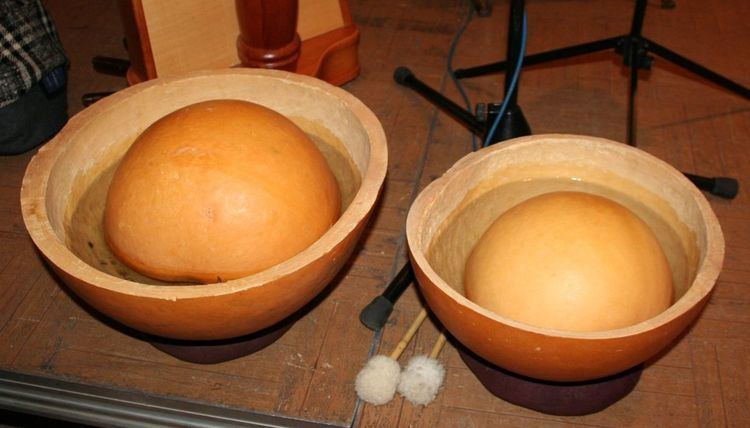 | ||
Water drums are a category of membranophone characterized by the filling of the drum chamber with some amount of water to create a unique resonant sound. Water drums are used all over the world, including American Indian music, and are made of various materials, with a membrane stretched over a hard body such as a metal, clay, or wooden pot.
Contents
Water drumming, the tambor de agua (Spanish: drum of water), bungo, or liquindi, of African origin, is water, such as a river, which is played by striking the surface directly with one's hands. It is performed by the Baka in Africa, and in South America by the descendants of slaves, with strokes comparable to the culoepuya.
Use
Water drums are used in Iroquois, Navajo, Cherokee, Creek, and Apache music, water drums are common in Native American music, being widespread in North and South America. They are used today both ceremonially and in traditional Longhouse social dances and are the traditional drum for the Huron/Wendat/Wyandot and Iroquois/Haudenosaune tribes. The Ojibwa, Odawa and Pottawatomii called them midegwakikoon, with "Mide" referring to Midewiwin. Water drums are used in Yaqui deer dance music.
Construction
Today they are made of both wood and clay. Wooden water drums are made either by hollowing out a solid section of a small soft wood log, or assembled using cedar slats and banded like a wooden keg. Clay drums are either handmade or an old crock is used. Wyandot and Seneca/Cayuga traditionally used a groundhog skin (daˀyęh) for the drum covering,though a piece of deer skin works well. An Iroquoian or Wendat/Wyandot drum stick is carved from a piece of hardwood with a small rounded tip. Each drum style has a unique way of tightening the hide to maximize the sound. The drum head must be both tight and saturated with water for best results.
Native American Church ceremonies often use a water drum made from iron, brass or copper kettle. These styles of water drum are more common than the woodland form and can be purchased in numerous locations. The distinctive sound of the drum characteristic of the Native American Church is created because: "The water inside is in constant motion and produces a special resonance. The player's thumb, pressed against the drum head, holds the tone at a constant pitch which then drops a fifth or more when the pressure is relaxed between songs."
Pop culture
Since approximately 2006, the American heavy metal band, Mushroomhead have used nontraditional water drums in their live show.
